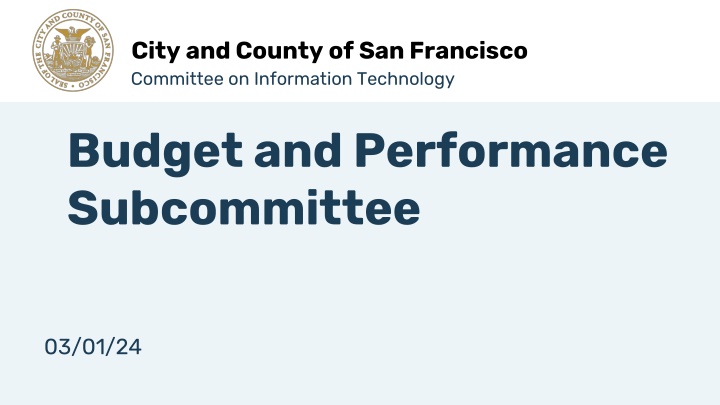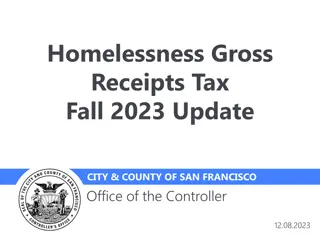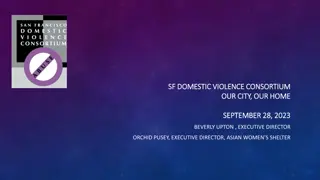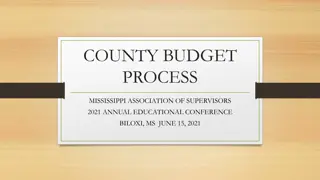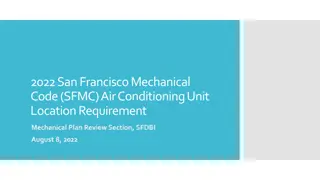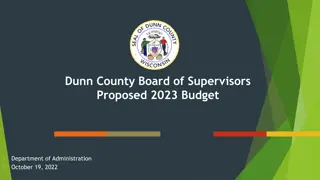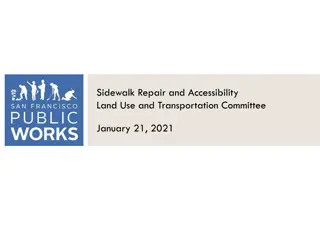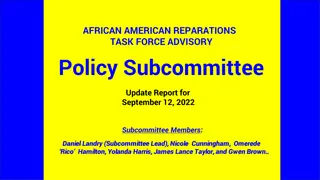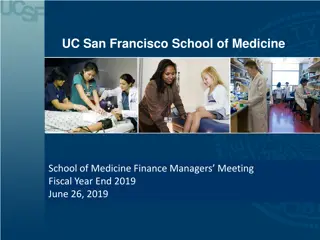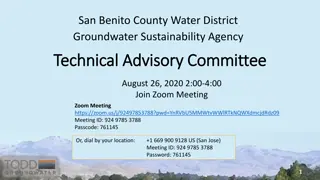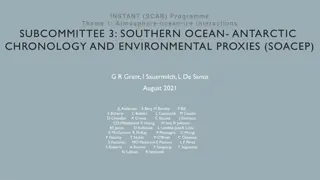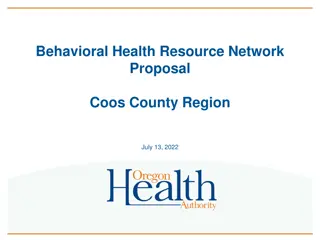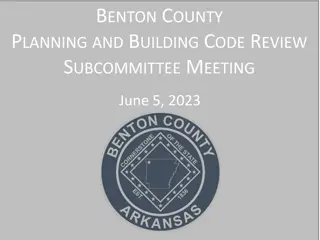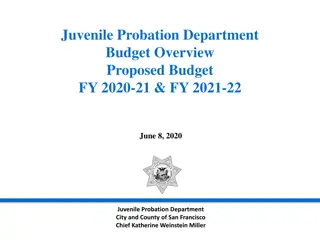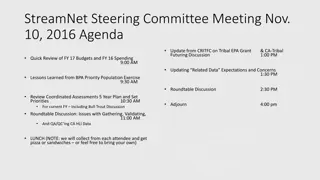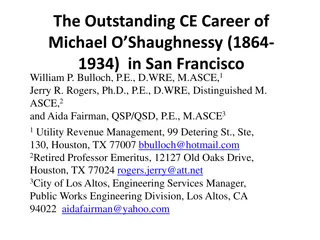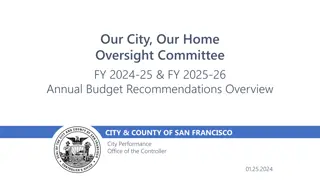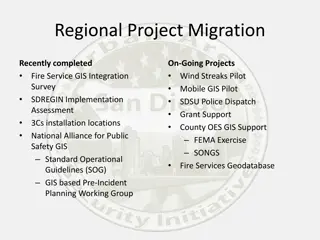City and County of San Francisco Committee on Information Technology Budget and Performance Subcommittee Meeting Agenda
The City and County of San Francisco Committee on Information Technology held a meeting to discuss various agenda items including public comments, department updates, budget presentations, and order of presentations. Topics covered included employee access to digital services, IVR enhancements, Lightweight CRM, JUSTIS Program, and Generative AI Center of Excellence. The meeting also delved into digital HR service delivery, personnel records, and employee access to city portals. Discussions centered around understanding projects in the context of HR services and workforce management.
Download Presentation

Please find below an Image/Link to download the presentation.
The content on the website is provided AS IS for your information and personal use only. It may not be sold, licensed, or shared on other websites without obtaining consent from the author.If you encounter any issues during the download, it is possible that the publisher has removed the file from their server.
You are allowed to download the files provided on this website for personal or commercial use, subject to the condition that they are used lawfully. All files are the property of their respective owners.
The content on the website is provided AS IS for your information and personal use only. It may not be sold, licensed, or shared on other websites without obtaining consent from the author.
E N D
Presentation Transcript
City and County of San Francisco Committee on Information Technology Budget and Performance Subcommittee 03/01/24
Agenda Call to Order by Chair Roll Call General Public Comment Department Updates and Announcements Approval of Meeting Minutes from February 2, 2024 (Action Item) FY 2024- 2025 & FY 2025- 2026 Budget Presentations Review the remaining schedule for Department presentations (March- April) Adjournment 2
Item Number 3 General Public Comment Discussion 3
Item Number 4 Department Updates and Announcements Discussion 4
Item Number 5 Approval of Minutes from February 2, 2024 Action item 5
Item Number 6 FY 2024- 2025 & FY 2025- 2026 Budget Presentations Discussion 6
Order of Presentations Employee Access to their City (Intranet/Employee Portal) (10:10AM - 10:30AM) IVR Enhancement (10:30AM - 10:50AM) Lightweight CRM (10:50AM - 11:10AM) JUSTIS Program (11:10AM - 11:30AM) Generative AI Center of Excellence (11:30AM-11:50AM) 7
DigitalHRService Delivery Onboarding &Electronic Personnel Records -and- Employee Access to their City (Intranet / SF|My Portal) Committeeon Information Technology FY 2024-2025
Understandingprojectsincontext Employee Relationships Performance Offboarding Sourcing Recruiting Assessing Vetting Workforce Structures Benefits and Payroll Learningand Development HR Service Modules Onboarding Compliance Succession Planning Alumni Relations Leaves Digital Personnel Record Records HRSupport Center Hiring Support Support Analytics & Reporting PeopleAnalytics Hiring Data SF Careers Intranet Comms& Presentation PeopleAnalyticsPortal Hiring Modules
Pastprojects:HiringNewATS& onlineexams Employee Relationships Performance Offboarding Sourcing Recruiting Assessing Vetting Learning and Develop ment Workforce Structures Benefits and Payroll HR Service Modules Onboarding Compliance Succession Planning Alumni Relations Leaves Digital Personnel Record Records HRSupport Center Hiring Support Support Analytics & Reporting Hiring Data PeopleAnalytics Intranet SF Careers Comms& Presentation PeopleAnalyticsPortal Hiring Modules
Our workis translating into meaningful impact Applicationvolume Hiring totals Vacancy rate Time-to-fill 46% 26% 33% 23% year-over-year increase year-over-year increase decreasesinceOct. '22 decreasecompared to Oct. '22 4
Onpathtoreimaginingexams Launched six continuous testingprocesses forhigh vacancy classes: Processed 10,000+ applicantssofar throughonline on-demandvendor (Vervoe) Processed scores andestablished eligible lists Piloted online on-demandvendor's functionality on 14 recruitments for behavioral consistency questionnaires, oral and multiple choice assessmentsfor various departments Theshortest recruitmenttimelinewas 22 days from receiving the request to set upand administer the exam to postingof theeligible list (9221 AirportOperationsSupervisor and CoreAadministration forPUC) Current median timeline is ~70 days Using lessons learned to inform procurement of additional online on-demand exam platforms which we hope to launch with new approach to assessments altogether
Currentprojects:Employeejourney Employee Relationships Performance Offboarding Sourcing Recruiting Assessing Vetting Workforce Structures Benefits and Payroll Learningand Development HR Service Modules Onboarding Compliance Succession Planning Alumni Relations Leaves Digital Personnel Record Records HRSupport Center Hiring Support Support Analytics & Reporting Hiring Data Startingon Workforce Data PeopleAnalytics Intranet SF Careers SF Careers Comms& Presentation PeopleAnalyticsPortal Hiring Modules
Problemand opportunity
Problemdescriptions Onboarding & ElectronicRecords SF|MyPortal Intranet Personnelfiles are paper: During COVID, files were inaccessible Searching the files of long-time employees is difficult Records are not reportable and the lack of structured data prevents usfrom using that information toenhance the employee experience Onboardingexperience is inconsistent Employees in different departments are given early access to information and services in an inconsistent way First part of the employee s journey with the Cityand the lack of consistency often prevents them from hittingthe ground running on Day One No one-stop shop to access everything you need as an employee Current employee portal is not extensible to address all use cases Employees access services differently depending on department Inconsistent access to HR services creates inequities between employees The costsassociated with maintaining paper recordsand siloed service delivery are expensive.
Potentialcostsavings Item FY 23-24 Savings SavingsType CON-SystemsInfrastructure Reduction $ Ongoing 20, 596 $ CON-SystemsUpgrade ProjectReduction Ongoing 209, 800 $ CON-OngoingPlatformSupport Ongoing 13, 650 $ 244,0 46 Improvedefficiencies Reduced redundancy when updating employee-facing documentation Emergency response and managementinformation sharing
Threemodulessupportingone goal ElectronicRecords Onboarding Portal The base of any employee s journey withthe City How an employee accesses services andmanagestheir own persona. Wherean employee s journey withthe City begins
Jointportalforaunified experience HR Services More Payroll My Portal Agent Workspace Procurement Requests IT Information Sharing Services
Projectcomponentsandstatus FY 22-23 23-24 24-25 Electronic Personnel Records Employee Profile Foundation Record Producer Workflow Design Iterative Delivery Digitization of PaperRecords Iteration Employee Onboarding System Integration Research Design Pilot Iteration Employee Portal Migration Multi- My Portal / Intranet UI Knowledge Population Additional Integration Department Expansion Development Completed In-progress Iteratingon
Whathasthis translatedintosofar?
Totalfundingrequest Portal/Intranet:New Ask FY24-25:+$1.3M, Total$2.0M Onboarding/Personnel Records: NewAsk FY24-25:+$1.3M, Total$1.3M
Non-stafffundingrequests Licensing Professional Services $900kin additionallicensing costs tosupport Employee JourneyswithinServiceNow Includes: ServiceNow Enterprise Upgrade for 35k Users Includes: Employee Document Management for 35k Users $750k in professional services tosupport rapiddevelopment and deployment of onboarding featureswithinternal teamto support managementand enhancement oftools intothe future.
Non-stafffundingtosupportdeliveryina year Enterpriselicensesallow for: Documentmanagement Departmentflexibilitywithmoreagencygivento managers Dedicatedworkflowspre-andpost-hire Pathwayto handleoffboardingas well Alumni(Retiree)access tosystems Professional servicesallow for: Expediteddevelopment of allworkflows pre-andpost-hire Withoutthesetwo pieces,we would likely only delivera very rudimentary solutionespecially in a world wherewe would needto developother solutionsfor documentmanagementinthedigitalpersonnelrecord
DEPARTMENT of Building Inspection Presentation to COIT Budget & Performance Subcommittee IVR Enhancement 3/1/2024
Project Overview Problem Statement Provide an automated inspection scheduling solution for all permit applicants. With the current IVR system, permit applicants can only schedule inspections via a phone call. Project Objective Implement inspection scheduling function via web and SMS with current IVR system. 28
Project 5-Year Financial Forecast FY24 FY24- -25 25 FY25 FY25- -26 26 FY26 FY26- -27 27 FY27 FY27- -28 28 FY28 FY28- -29 29 COIT Allocation Other Sources $300,000 $60,000 $63,000 $66,000 $69,000 Total Project Funding $300,000 $60,000 $63,000 $66,000 $69,000 29
High-Level Project Plan List key project activities in left-hand column, known dates of key milestones in second column, and adjust length/position of blue bars and diamonds to indicate time period/duration for listed activities. FY24 FY24 FY24 FY24 FY24 FY24 FY25 FY25 FY25 FY25 FY25 FY25 FY25 FY25 Dates of Dates of Quarter/FY Quarter/FY Key Key FY26 FY26 FY27 FY27 FY28 FY28 Q2 Q2 Q3 Q3 Q4 Q4 Q1 Q1 Q2 Q2 Q3 Q3 Q4 Q4 Milestones Milestones Project Initiation Project Initiation Contracting Project Kick-off Implementation Implementation Requirements gathering System configuration UAT UAT Go Go- -live live 30
Measuring Project Success Key Performance Indicator(s) Current inspections scheduling stats DBI Staff 50% IVR 50% Within 1 year of system Go-Live, inspections scheduling stats will be DBI Staff 25% IVR 25% Web/SMS 50% 31
[For remaining slides, complete either a set for each project or one set addressing all of Department s projects collectively] Risk Mitigation Strategies
Project Risk Management Plan COIT considers a thoughtful list of potential risks and plan to address them to be a strength. For a helpful reference on types of project risk, see this this resource. Below, please discuss the risks this project might face. What could fail and why? How would you prepare for these risks? Some common risks are pre-populated below, but feel free to change these feel free to change these as appropriate for your project. Potential Risk #1: Budget Overrun and/or Vendor Delays Your Plan to Prepare for/Mitigate this Risk Factor in 20% as a budget buffer. Rigorous reference check on potential vendor during RFP phase. Potential Risk #2: Project Scope Creep (project deliverables expand beyond original plan and exceed available resources) Your Plan to Prepare for/Mitigate this Risk Adopt PMI scope management methodology. Focus on scope control which align defined scope against requirements collected. Potential Risk #3: Staffing/Capacity for Implementation, Deployment, Training Your Plan to Prepare for/Mitigate this Risk Resource planning during project initiation. Identify business SMEs and project participants, prioritize project tasks over operational tasks for all project SMEs and resources. 33
Project Risk Management Plan, Continued Below, please answer two questions related to a scenario in which your project does not receive funding. Consequences of Not Funding One of DBI s strategic goal is to improve inspection turnaround time. The consequence for not implementing this system will prevent DBI meeting this strategic objective. Alternate Plans If project is not funded, DBI will explore the feasibility of developing an interim scheduling system by internal IT team. DBI will hire additional staff to provide scheduling service over current phone system. 34
Change Impact Assessment Purpose: This template can help you determine the degree and complexity of change your project entails. It also brings focus to who and what is impacted, which can sharpen your plans for communication and training. Impact Analysis Dimension of Change Description of the change There will be minimal impact to operation since this project will not change current inspection processes and workflows. Operational Impact Policy & Management Impact There will be minimal impact to DBI policy and management since this project will not require new surveillance or cybersecurity technology. Impact to Specific Roles/Teams, Departments, Residents This project will have minimal impact on DBI employees. It will provide an additional service to local property owner and permit applicants with the intent of improving overall inspection turnaround time. 35
DEPARTMENT of Building Inspection Presentation to COIT Budget & Performance Subcommittee Lightweight CRM 3/1/2024
Project Overview Problem Statement DBI is the execution department for many local legislations related to building safety and in many cases which will require customer to register and provide their contact information as part of the process. Project Objective Implement a lightweight CRM system for DBI to store and track customer contact information. 39
Project 5-Year Financial Forecast FY24 FY24- -25 25 FY25 FY25- -26 26 FY26 FY26- -27 27 FY27 FY27- -28 28 FY28 FY28- -29 29 COIT Allocation Other Sources $300,000 $60,000 $63,000 $66,000 $69,000 Total Project Funding $300,000 $60,000 $63,000 $66,000 $69,000 40
High-Level Project Plan List key project activities in left-hand column, known dates of key milestones in second column, and adjust length/position of blue bars and diamonds to indicate time period/duration for listed activities. FY24 FY24 FY24 FY24 FY24 FY24 FY25 FY25 FY25 FY25 FY25 FY25 FY25 FY25 Dates of Dates of Quarter/FY Quarter/FY Key Key FY26 FY26 FY27 FY27 FY28 FY28 Q2 Q2 Q3 Q3 Q4 Q4 Q1 Q1 Q2 Q2 Q3 Q3 Q4 Q4 Milestones Milestones Project Initiation Project Initiation Contracting Project Kick-off Implementation Implementation Requirements gathering System configuration UAT UAT Go Go- -live live 41
Measuring Project Success Key Performance Indicator(s) Current state: Lack of customer contact information tracking mechanism. Expected future state: Self-service register and contact information tool can be provisioned and configured within 30 days of an legislation adoption. 42
JUSTIS Program: Project Objective Emergency Mgmt. CA L DO J Modernizing the JUSTIS Hub to Improve Delivery of Services and Reduce Long-Term Technical Debt Deploying the JUSTIS API to integrate with partner agencies Converting Oracle SOA Suite to Python to reduce costly Oracle licenses JUSTIS Migration Cloud DR in the Cloud Establish the Data Center of Excellence (DCoE) - Operating Model and Governance and Reporting and Analytics Expanding the Data Integration Hub and establish the Data Sharing Capabilities Finalizing Operating Agreement and Service Levels Provide consultative support to agencies developing queries and reports on inter- agency data Prepare and maintain the JUSTIS Data Taxonomy Provide centralized Data Quality Assessments Prepare periodic assessments of DCoE effectiveness Police Department Juvenile Probation Sheriff s Office JUSTIS Data Hub Superior Court Adult Probation Public Defender District Attorney 45
JUSTIS Program: Performance Measures Completed FY23/24: Completed development of a JUSTIS hub that connects eight departmental case management systems and shares data across these systems. Completed the new JUSTIS / Courts system integration. Daily Average of 17,000 Messages Received From the Courts & 2,000 Messages Sent to the Courts Business applications for querying the data Hub and producing alerts and notifications have been developed. Submitted Workplans for Performance & Strategy, Data & Architecture, Systems & Large Projects, Operations & Maintenance Planned FY24/25: Build JUSTIS API to Integrate With New Systems at The Sheriff's Office and District Attorney's Office Disaster Recovery on Azure - Proof of Concept Database Migration from CMS14 to Data Lake, allowing JUSTIS to support additional data and features Convert old Oracle SOA Suite to Python 46
JUSTIS Program: Business Benefits & Impact Business Benefits: Reducing Technical Debt: Focusing on technical goals which will allow us to retire legacy software & hardware that is costly to maintain. Goal is to reduce operating costs long-term Governance: Continue maturing JUSTIS governance initiatives Data in the format that each agency needs Easy to maintain, Less points of failures Major Stakeholders: Public Safety & Criminal Justice Primary Users: Public Safety & Criminal Justice 47
JUSTIS Program: Funding Request FY2027-28 FY2028-29 FY2029-2030 FY2024-25 FY2025-26 FY2026-27 Upcoming Need = $1.64M Carry Over = $2.1M $1.70M $1.47M $925K $300K $0 Total Project Costs High Net Ask = $0 Upcoming Need = $1.41M Carry Over = $2.1M $1.45M $1.22M $675K $300K $0 Low Net Ask = $0 $0 $1.70M $1.47M $925K $300K $0 Funding requested from COIT Breakdown of Funding Ask: FY2024-25 FY2025-26 Data Center of Excellence: Business Analyst Contractor (1) Lead Business Data Coordinator 1054-O $230,000 $250,000 $230,000 $250,000 Project Manager 5502-T $257,000 $257,000 Data Lake/Data Warehouse subscription/licensing Data Catalog JUSTIS Hub Enhancements: APEX Developer / API Developer (Contractor) Oracle Licenses Python Developer TEX 1063-T01 Test Agency DR recovery Engineer cloud back-up environment Total: $50,000 $30,000 $75,000 $50,000 $220,000 $400,000 $200,000 Existing Staff Existing Staff $1,637,000 $220,000 $400,000 $220,000 Existing Staff Existing Staff $1,702,000 48
Gen AI Center of Excellence
Gen AI Center of Excellence: Problem Statement Gen AI is a term used to describe the next generation of artificial intelligence technologies, characterized by advancements in learning, adaptation, and problem-solving abilities, potentially rivaling or surpassing human intelligence. It is capable of generating text, images or other data using generative models, often in response to prompts. Background: Generative Artificial Intelligence (Gen AI) has great potential to provide public benefits. When used appropriately, the Gen AI tools have the potential to expand the City s toolkit for public service. The Gen AI Center of Excellence will provide guidance, set best practices, and coordinate with all City departments to be aligned use of Gen AI so that it can use be used effectively. It will help advance a unified Gen AI vision within the City and a standard framework for Gen AI adoption to ensure there is an appreciation of Gen AI benefits, risks and limitations. Problem Statement: CCSF is in early stage of Gen AI Evaluation, the Gen AI Center of Excellence will help in effectively adoption of Gen AI technologies across various departments so that it can be used effectively. 50
